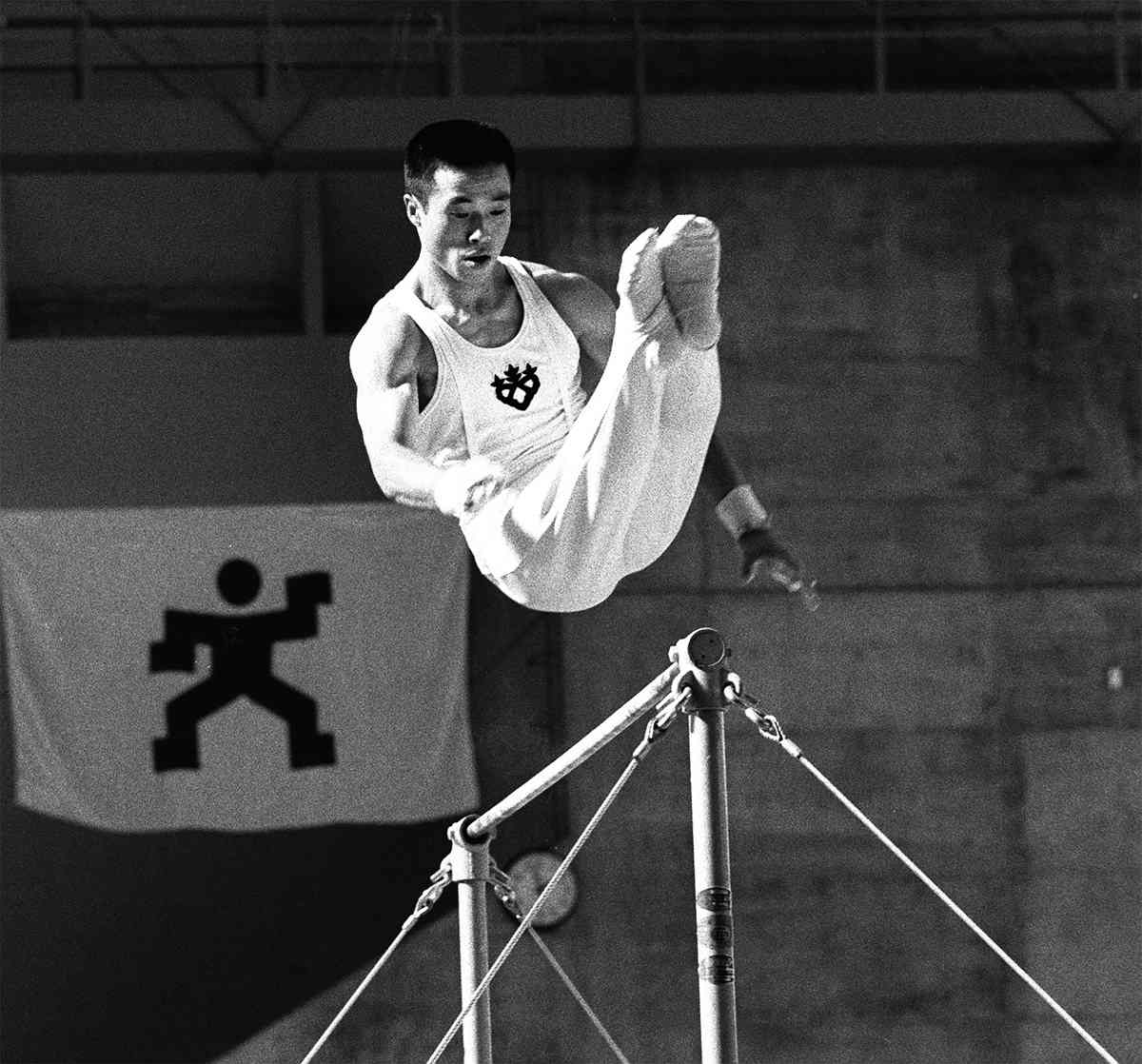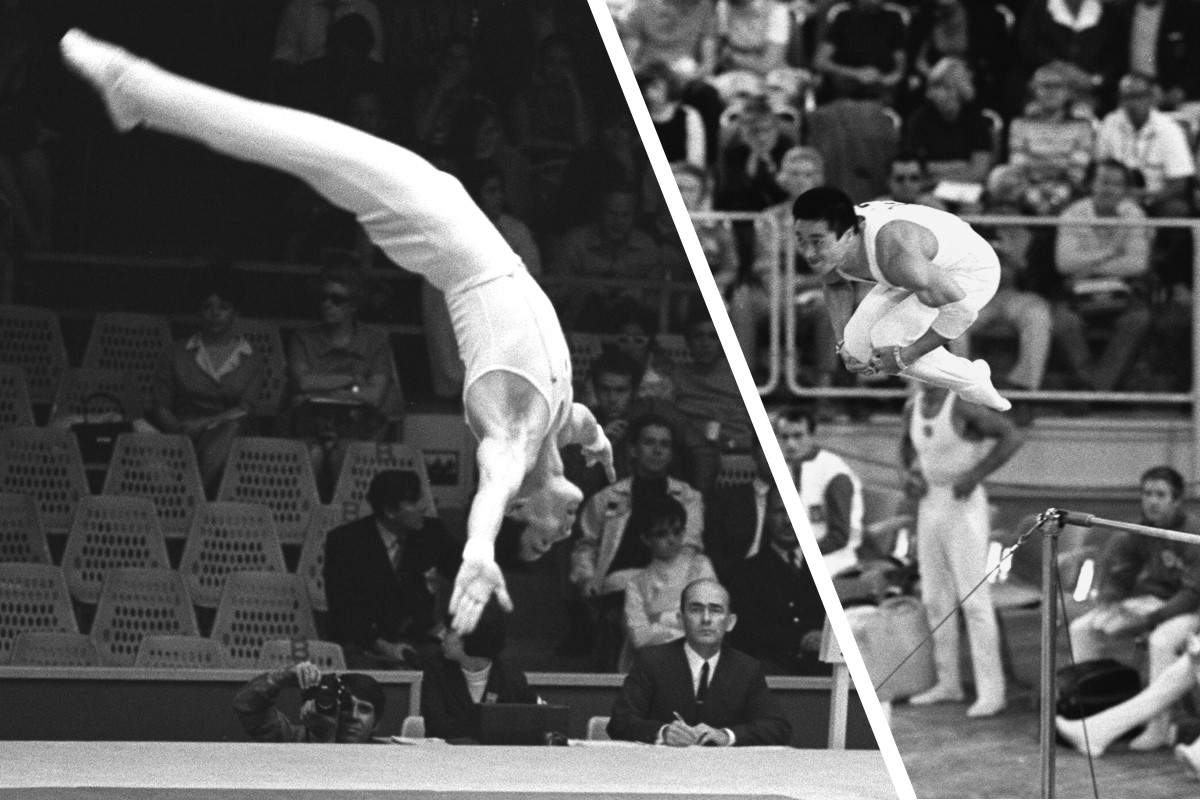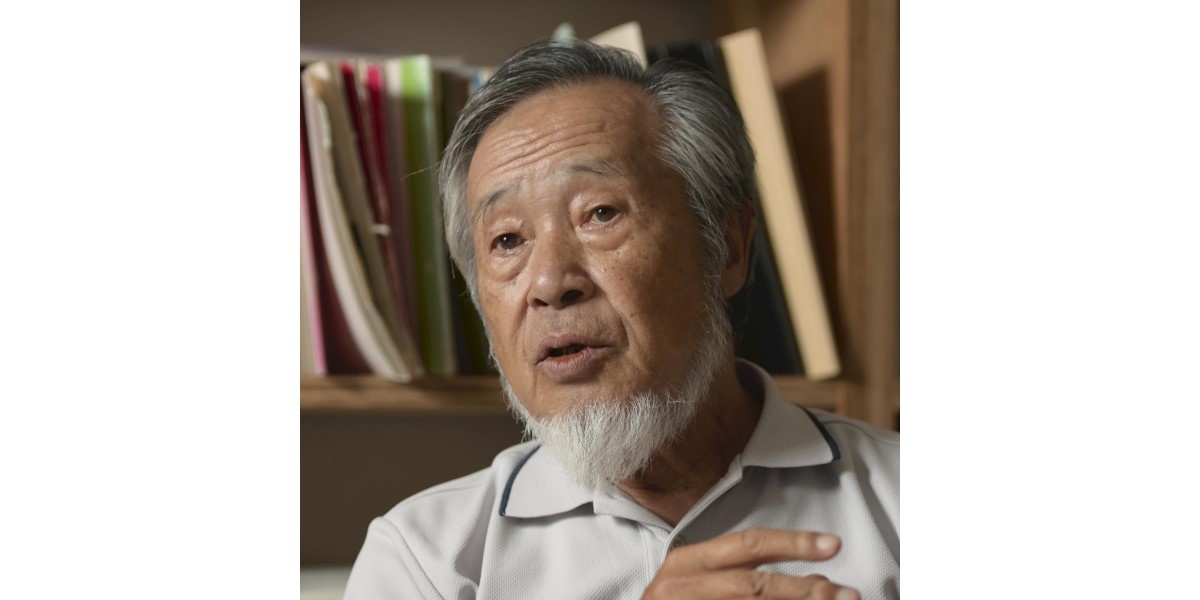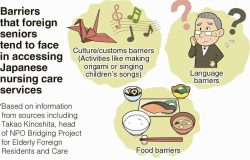
Kato performs on the high bar in the All-Japan Artistic Gymnastics Championships in Nagano, in 1975, which also served as the first qualifying round for the Montreal Olympic Games.
11:29 JST, September 19, 2023
When Sawao Kato was a child, his older brother made fun of his name, which combines a kanji character meaning “enough” with another character meaning “man,” saying, “Your name means ‘We have enough men.’” Kato complained about it to his father, but his father said: “No, your name does not mean that. The kanji character used in your name is meant to express ‘brightness.’” Of course, Kato did not yet know his bright future as a gymnast. He won a total of eight gold medals in three Olympic Games, which is still the most gold medals won by any Japanese athlete in any Olympic sport.
Kato was born in the town of Muramatsu, present-day Gosen, Niigata Prefecture. He was one of five siblings — two older brothers, one older sister and one younger sister. He played in the river and the harvested fields and rice paddies until he was exhausted every day. “Looking back, I think I learned how to use my body by falling down a lot,” Kato said. After he entered junior high school, he wanted to join a baseball club. However, his second-oldest brother, who had failed a university entrance exam, was opposed. “If you join a club, you’ll neglect your studies,” he said. “You’ll end up like me.” So, Kato gave up the idea.
The turning point came a month after he entered junior high school. In his PE class, students were supposed to learn the long jump but it was suddenly changed to the horizontal bar. Some students, including Kato, were called to a teacher’s office where they were asked to join the gymnastics club by the teacher in charge of it. Ahead of the 1964 Niigata National Sports Festival, the prefectural board of education was apparently scouting talent.
Kato’s talent and potential having been recognized, he joined the club behind his family’s back and improved his skills. After getting into the prefectural Niigata Minami High School, Kato — as expected — came first in the team event in the boy’s division of the National Sports Festival held in his prefecture and entered Tokyo University of Education (now the University of Tsukuba). When he was a senior, he made his Olympic debut in Mexico in 1968 and won a gold medal in the individual all-round. At the 1972 Munich Olympic Games four years later, Kato became the first Japanese athlete to win a gold medal in the individual all-round in two successive Olympic Games. It was the golden age of “Gymnastics Japan,” and Kato said, “I was determined to carry Japan’s artistic gymnastics on my back.” After the 1976 Montreal Olympics, Kato had a total of 12 Olympic medals including silver and bronze.
Traditionally, Japan has focused on gymnastic beauty and many officials believe that this tradition comes from Kato. Kato himself wonders who came up with that idea. However, his straight-stretched toes and knees and relaxed line from neck to shoulder emphasized the sharpness and elegance of his performance. His artistic gymnastics performances, which paid attention to every single body part, were praised all over the world as “textbook.”
What drove him were adoration and an inferiority complex.

Left: Kato gives a beautiful performance in the floor exercise at the 1968 Mexico Olympics.
Right: Kato finishes his performance with his toes stretched straight at the Munich Olympics in 1972.
Kato adored Yukio Endo, who won a gold medal in the individual all-round in the 1964 Tokyo Olympic Games and died in 2009. “His knees were in the perfect position and his leg lines were straight. I envied him.” Kato was troubled by his bowlegs. In addition, he suffered from an inferiority complex when comparing himself to foreign athletes. “When I sat next to foreign gymnasts in a competition with Russia, for example, I was surprised by the difference in limbs and bones. Their legs were long and their toes were like pen points. I was disappointed by my own legs and feet,” Kato said.
Kato tried to adjust his knee joints so that his legs looked bent back. When he aligned his legs, he tried to strongly squeeze them inward. Applying great force to the lower body fundamentally changed the way he performed. He longed for gymnastic beauty so much that he devoted himself to steady practice. It was so difficult that he said, “I had to rebuild all my techniques.”
He also paid close attention to clothing. He adjusted the position of the seams of his tights. He asked an apparel maker to make the seams twist inward, not stretch straight, from thigh to knee and stretch outward from knee to toe. He thought that if the seams looked like the letter “X,” it would help lessen the impression of bowlegs. “I went to a factory and sat next to a sewing machine. That must have caused a lot of trouble for them,” Kato said, recalling those days with slight embarrassment.
In a photo of him in his prime, his legs were held tightly during a performance and you could never tell that he had been troubled by bowlegs in the past.
After retiring from competition, Kato contributed to the development of artistic gymnastics and young athletes by serving as a technical committee member of the International Gymnastics Federation while he worked as a professor at the University of Tsukuba and Hakuoh University where he continued to teach “general exercise science.” Roughly speaking, this is the study of the importance of exercises learned through actual practice, rather than from the perspective of dynamics or physiology.
He retired from teaching and his title was changed to professor emeritus for both universities.
In October, he turns 77. “Every day is Sunday for me now,” he laughed, but he goes to his laboratory at the University of Tsukuba every day for research. “I think I should compile what I have learned and taught,” he said. Just like artistic gymnastics in which he pursued his ideal performance, he said there is no goal for learning.

Sawao Kato, a former gymnast who holds the most Olympic gold medals for an individual Japanese athlete, speaks to The Yomiuri Shimbun in Tsukuba, Ibaraki Prefecture, in July.
‘Practice is everything’
The Japanese men’s gymnastics team won gold medals in five consecutive Olympic Games from the 1960 Rome Olympic Games and in five consecutive Artistic Gymnastics World Championships starting with Prague in 1962. Among the individual team members, Kato’s amount of practice reportedly stood out.
Another Olympic gold medalist Mitsuo Tsukahara, 75, who demonstrated the “moon salto” in the horizontal bar and the Tsukahara vault technique, said, “Kato was the last person I wanted to imitate.” But he also said with a smile, “He was the person I admired the most.”
“He practiced simple techniques that he had [already] perfectly acquired dozens of times. Since I am the kind of person who wants to try something new, it annoyed me watching him. But I knew that such a gymnast would be a champion,” Tsukahara said.
Kohei Uchimura, 34, won his second consecutive gold medal in the individual all-round in the 2016 Rio de Janeiro Olympics. He cited the day Kato told him during the national team training camp in 2007, “The best athletes in the world are the athletes who practice most in the world,” as a turning point in his gymnastics career.
Once Kato had mastered a technique, he intentionally made mistakes in daily training so that his body thoroughly learned the technique. “Practice is everything, everything is practice,” he said. That was his consistent style.

Japanese gymnasts dominate the podium in men’s individual combined exercises at the Munich Olympics. From left, Eizo Kenmotsu with a silver medal, Kato with a gold medal and Akinori Nakayama with a bronze medal.
The Legend feature profiles era-defining figures in culture, sports and other fields.
"JN Specialities" POPULAR ARTICLE
-

The Japan News / Weekly Edition (12/12-12/18)
-

English-language Kabuki, Kyogen Entertain Audiences in Tokyo; Portland State University Professor Emeritus, Graduates Perform
-

Noodle Dining Shunsai / Rich Oyster Ramen to Savor at Odasaga; Experienced 68-year-old Owner Creates Numerous Ramen Varieties
-

The Japan News / Weekly Edition (12/5-12/11)
-

People Keep Loved Ones’ Ashes Close in Special Jewelry, Small Urns as Unique Way to Memorialize Them
JN ACCESS RANKING
-

Keidanren Chairman Yoshinobu Tsutsui Visits Kashiwazaki-Kariwa Nuclear Power Plant; Inspects New Emergency Safety System
-

Imports of Rare Earths from China Facing Delays, May Be Caused by Deterioration of Japan-China Relations
-

University of Tokyo Professor Discusses Japanese Economic Security in Interview Ahead of Forum
-

Japan Pulls out of Vietnam Nuclear Project, Complicating Hanoi’s Power Plans
-

Govt Aims to Expand NISA Program Lineup, Abolish Age Restriction






















